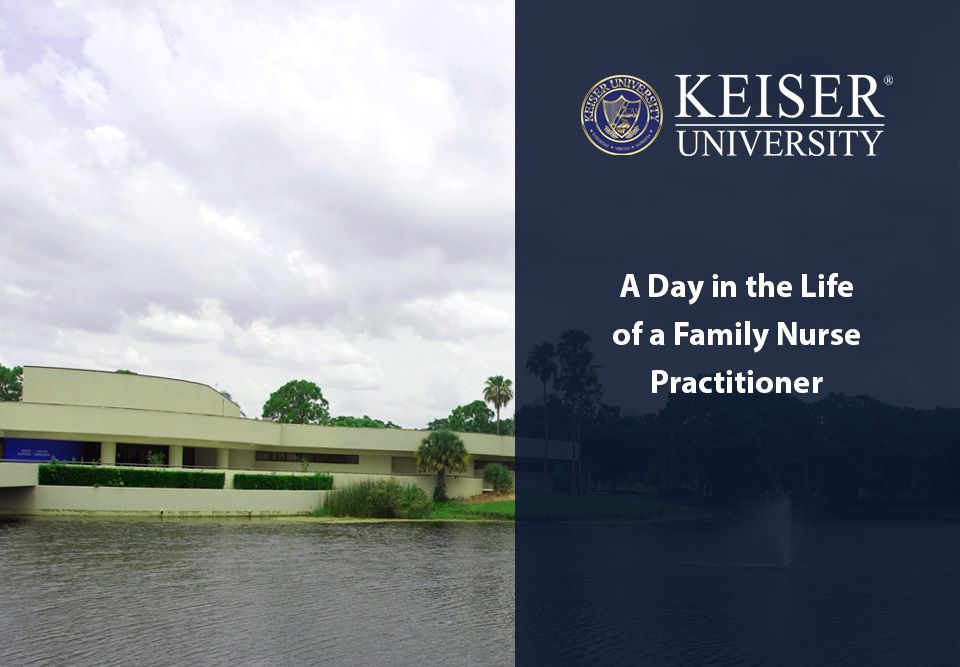If there is one thing for certain, it is that the day in the life of a nurse is never boring. Depending on your role and the patient population that you serve, you may take on a wide range of responsibilities and tasks on any given day. As you consider opportunities for advancing your nursing career, in particular, you may wonder about the day in the life of a nurse practitioner (NP).
Before you strive toward this advanced practice registered nursing (APRN) position, it can be helpful to understand more about the day in the life of a master’s student. Nurses who want to become family nurse practitioners will need to earn a Master of Science in Nursing (MSN) and may want to consider choosing a specialized advanced nursing degree that focuses on the skills required to become a family nurse practitioner (FNP). Or a nurse could pursue a Doctor of Nursing Practice.
What Is a Family Nurse Practitioner (FNP)?
Nurse practitioners are advanced practice registered nurses able to provide comprehensive healthcare services to patients, and family nurse practitioners specialize in family-focused healthcare services. According to the American Association of Nurse Practitioners (AANP), FNPs work with patients of all ages. Many of these nurses have a broad scope of practice, but others choose to pursue certifications in specialized areas to narrow their scope.
According to the American Nurses Association (ANA), approximately 70% of all nurse practitioners are family nurse practitioners. Given that they are often able to provide many of the same healthcare services as primary care physicians, they play a critical role in today’s overburdened healthcare system.
Why Understanding the FNP Role Matters
By exploring the role of FNPs in the modern healthcare landscape and learning more about what daily life is like for these APRNs, you can decide if this is the right career pathway for you, plus gain a better idea of their place in the healthcare system as a whole. Family nurse practitioners are able to provide direct patient care, and they work with patients from infancy through adulthood — enabling them to form lasting connections with their patients.
Morning Routine and Preparation for the Day
While FNPs work in a variety of healthcare settings, the vast majority operate out of primary care offices and private clinics. As a result, many enjoy daytime shifts and more traditional hours than registered nurses who work in hospitals. Family nurse practitioners often begin each day with a morning routine that allows them to feel prepared and organized before they start to work with patients.
Starting the Day as a Family Nurse Practitioner
As a family nurse practitioner, you will likely see a wide range of patients throughout the day. Starting out on a positive and organized note will help you feel prepared for what the day has in store. Many FNPs choose to arrive at work before their first appointment is scheduled so that they can review their patient caseload for the day and take care of any workflow planning in advance.
Pre-Shift Responsibilities and Daily Workflow Planning
The pre-shift responsibilities of an FNP may vary based on the individual position, the number of patients the FNP works with each day and the location where they work. In general, FNPs begin their day by:
- Reviewing patient history/information and evaluating their patient caseload for the day.
- Responding to messages, checking lab results and following up with other providers.
- Preparing supplies and equipment, along with hygiene and disinfection measures.
Clinical Responsibilities Throughout the Day
Any day in the life of a nurse practitioner truly begins when they start to see their patients. The number of patients that an FNP is able to see on a daily basis will depend on the size of their office and the current level of demand, which can ebb and flow seasonally. According to the ANA, some of the clinical responsibilities that FNPs take on throughout the day include:
Conducting Patient Assessments
Family nurse practitioners are responsible for assessing and evaluating their patients. They will review their health history with them, discuss the symptoms they are experiencing and perform any necessary health screenings. FNPs are typically able to spend more time with their patients than physicians, allowing them to actively listen and conduct a thorough assessment during the patient’s appointment.
Diagnosing and Managing Health Conditions
Due to their advanced education, ongoing training and extensive experience, family nurse practitioners can diagnose their patients and provide them with a treatment plan. The ability to diagnose and treat patients sets FNPs apart from registered nurses — who can assess and triage patients but not develop a treatment plan on their own.
Prescribing Medications and Ordering Tests
After a patient has been diagnosed, family nurse practitioners can create a treatment plan without the supervision of a physician. Depending upon their state licensure, they may prescribe medication for patients who need it and order diagnostic tests, which allows FNPs to provide comprehensive healthcare services for their patients.
Patient Education and Preventive Care
Family nurse practitioners emphasize preventive care within their scope of practice. According to the AANP, family nurse practitioners educate their patients as well as caregivers by:
- Providing patients with health materials that help them better understand the actions they can take to live a full and healthy life.
- Connecting patients and their caregivers with community resources that can help them achieve a higher quality of life.
Working With a Collaborative Healthcare Team
Family nurse practitioners work to foster relationships with patients and deliver personalized care. In turn, they may collaborate with other healthcare treatment providers to help ensure that their patients are receiving the support and care they need to achieve the best possible outcomes. Whether partnering with other providers in the office or connecting with specialists in other facilities, family nurse practitioners tend to prioritize team collaboration in healthcare.
Evening Wrap-Up and Post-Shift Responsibilities
After a whirlwind day of working with patients — some of whom may have been in for routine well-visits or experiencing complicated symptoms — family nurse practitioners must wrap up their work before they head home. Similar to pre-shift responsibilities, post-shift responsibilities will vary based on the position, but in general, FNPs work to make sure that they are organized before they leave for the day.
Final Chart Reviews and Patient Messages
When the final patient has left for the day, family nurse practitioners often spend a few moments in their office making sure that they have taken care of all of their administrative tasks. During this time, they will usually review charts one more time and respond to any patient messages that may have come in throughout the day.
Preparing for the Next Day
Knowing that organization is the key to providing patients with the best possible care, family nurse practitioners will spend a few moments readying themselves for the next day before they leave the office. They may make a to-do list, or review the charts of patients whom they plan to see the following day.
Maintaining Work-Life Balance as an FNP
The role of an FNP can feel all-consuming at times. According to the Journal for Nurse Practitioners, the best way for FNPs to achieve a sense of work-life balance is to:
- Manage time effectively at work in order to reduce the need to complete administrative tasks, such as responding to patient messages, at home.
- Set clear and effective boundaries to protect personal time and optimize productivity at work. For example, FNPs may choose to avoid checking work e-mails during their non-working hours.
- Prioritize self-care. Nurses constantly have to give of themselves in order to care for their patients, and family nurse practitioners need to take time to do things that they enjoy, as self-care is one of the most effective ways to prevent burnout.
Managing Documentation and Administrative Duties
The bottom line is, FNPs are passionate about their patients, and they prefer to work directly with them. However, administrative duties are part of the job, and FNPs have to know how to manage those tasks effectively.
Some documentation and administrative duties that FNPs may be responsible for include:
Charting Patient Encounters and Follow-Ups
Whether a family nurse practitioner has worked with a patient in the office or provided them with support over the phone, they will need to record information about those encounters and identify any follow-up tasks that need to be completed. These encounters are often included as part of a patient’s electronic health record.
Communicating With Insurance Providers
In some cases, FNPs may need to communicate with insurance providers in order to verify that a patient has coverage for the healthcare services they require.
Handling Electronic Health Records (EHRs)
Family nurse practitioners are responsible for updating, managing and handling electronic health records for their patients. In the modern healthcare landscape, EHRs are playing an increasingly integral role in ensuring that patients have access to comprehensive healthcare treatment services.
Frequently Asked Questions (FAQ)
What’s the difference between an FNP and a general nurse practitioner?
Family nurse practitioners take a family-oriented approach to healthcare, which emphasizes shared decision-making and prioritizes preventative care. FNPs work with patients of all ages, whereas general nurse practitioners may choose to specialize in a particular area in order to narrow the scope of their practice.
Is there a high demand for family nurse practitioners?
With fewer physicians available, there is increased demand for qualified and experienced family nurse practitioners. Patients are finding that they prefer to work with FNPs, largely because these professionals are able to spend more time with their patients and known for providing personalized care.
Can I complete an FNP program entirely online?
Yes, the FNP program coursework can be completed entirely online, offering flexibility and versatility for nurses who want to advance their careers and specialize in advanced practice registered nursing. However, all FNP programs require face to face clinical hours working with preceptors.
Learn More About a Day in the Life of Nurse Practitioners at Keiser University Graduate School
As you begin to explore the nursing profession, many might wonder, “What is a typical day for a nurse practitioner?” At Keiser University Graduate School, we offer a Master of Science in Nursing, Family Nurse Practitioner degree focused on the specialized knowledge and clinical skills required for advanced practice nursing. With its family-oriented approach, the curriculum for this graduate degree program prepares you to navigate a day in the life of a nurse practitioner. Request more information today.






 The instructors at Keiser University impacted my life. They believed in my ability to become a great graphic designer, regardless of how I felt about my skills. KU helped to prepare me for the real world and got me to where I am today.
The instructors at Keiser University impacted my life. They believed in my ability to become a great graphic designer, regardless of how I felt about my skills. KU helped to prepare me for the real world and got me to where I am today.
